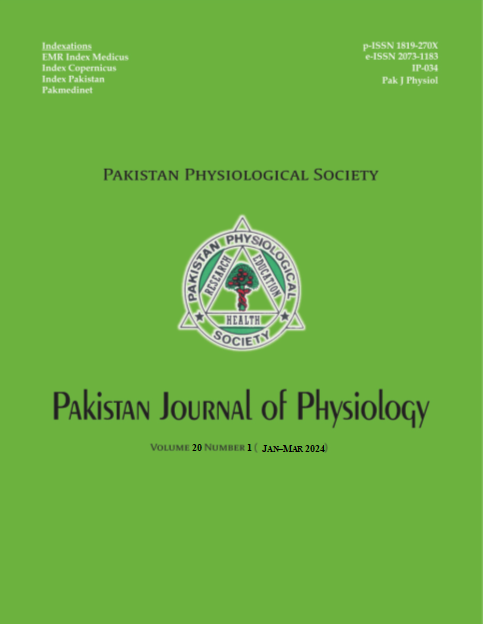PREVALENCE OF DYSLIPIDEMIA AMONG PATIENTS OF POLYCYSTIC OVARIAN SYNDROME: A CROSS SECTIONAL ANALYTICAL STUDY
DOI:
https://doi.org/10.69656/pjp.v20i1.1599Keywords:
Polycystic Ovarian Syndrome, Dyslipidemia, Metabolic Syndrome, PCOSAbstract
Background: Polycystic ovarian disease is a genetically complicated condition, most prevalent in women of reproductive age group. It is strongly associated with obesity, dyslipidemias, and menstrual disorders. Objective of this study was to determine the prevalence of dyslipidemia in patients of polycystic ovarian syndrome (PCOS). Method: A cross-sectional analytical study was conducted at the Department of Gynaecology, Bahawal Victoria Hospital, Bahawalpur, from 1st Jan to 31st Dec 2021. All newly diagnosed patients of PCOS between the ages of 18 and 35 with a BMI <25 Kg/m2 were included in the study. Participants were divided into subgroups according to their age and BMI. The fasting lipid profile was measured through a blood sample taken from each patient after an overnight fast. Total cholesterol >200 mg/dL, LDL-C >130 mg/dL, Triglycerides >150 mg/dL, and HDL-C <40 mg/dL were labelled as dyslipidemia. Chi-square test was used to calculate and estimate the relative risk (RR) of any associations observed. Results: Among total 286 analysed patients of PCOS, mean age was 24.4±5.367 years and mean BMI was 21.01±1.912 Kg/m2. Sixty nine (24.13%) patients had dyslipidemia. Patients in the 18–27 age group and a BMI of 21–23 Kg/m2 were more likely to have dyslipidemia with PCOS, [RR 44.90; 95% CI (16.93, 119.04); p<0.001], and [RR 32.12; 95% CI (8.02, 128.61); p<0.001] respectively. Conclusion: Dyslipidemia is seen in 24.13% individuals with PCOS. Screening in routine is recommended.
Pak J Physiol 2024;20(1):19-21
Downloads
References
Joham AE, Norman RJ, Stener-Victorin E, Legro RS, Franks S, Moran LJ, et al. Polycystic ovary syndrome. Lancet Diabetes Endocrinol 2022;10:668–80.
Abraham Gnanadass S, Divakar Prabhu Y, Valsala Gopalakrishnan A. Association of metabolic and inflammatory markers with polycystic ovarian syndrome (PCOS): an update. Arch Gynecol Obstet 2021;303(3):631–43.
Osibogun O, Ogunmoroti O, Michos ED. Polycystic ovary syndrome and cardiometabolic risk: Opportunities for cardiovascular disease prevention. Trends Cardiovasc Med 2020;30(7):399–404.
Grundy SM. Metabolic syndrome update. Trends Cardiovasc Med 2016;26(4):364–73.
Jatoi NA, Elamin YA, Said AH, Al-Namer B, Al-Muallim FA, Al-Nemer FF, et al. Prevalence of cardiovascular risk factors among patients with diabetes mellitus type 2 at King Fahad University Hospital, Saudi Arabia. Cureus 2022;14(9):e29489.
Legro RS. Obesity and PCOS: Implications for diagnosis and treatment. Semin Reprod Med 2012;30(6):496–506.
Monteiro R, Azevedo I. Chronic inflammation in obesity and the metabolic syndrome. Mediators Inflamm 2010;2010:289645.
Jang AY, Han SH, Sohn IS, Oh PC, Koh KK. Lipoprotein(a) and cardiovascular diseases–revisited. Circ J 2020;84(6):867–74.
Coppinger C, Movahed MR, Azemawah V, Peyton L, Gregory J, Hashemzadah M. Phomprehensive review of PCSK9 inhibitors. J Cardiovasc Pharmacol Ther 2022;27:1–14.
Rhee EJ, Kim HC, Kim JH, Lee EY, Kim BJ, Kim EM, et al. 2018 Guidelines for the management of dyslipidemia. Korean J Intern Med 2019;34(4):723–71.
He N, Ye H. Exercise and Hyperlipidemia. In: Xiao J. (Ed). Physical exercise for human health. Singapore: Singapore; 2020. p.79–90.
Sadeghi HM, Adeli I, Calina D, Docea AO, Mousavi T, Daniali M, et al. Polycystic ovary syndrome: a comprehensive review of pathogenesis, management, and drug repurposing. Int J Mol Sci 2022;23(2):583.
Wang C, Wu W, Yang H, Ye Z, Zhao Y, Liu J, et al. Mendelian randomization analyses for PCOS: evidence, opportunities, and challenges. Trends Genet 2022;38(5):468–82.
Tingthanatikul Y, Sripilaipong S, Vallibhakara O, Sophonsritsuk A, Weerakiet S, Vallibhakara SA. A comparative study of LDL-C levels in polycystic ovary syndrome women with different cardiovascular risks according to American Heart Association criteria. J Med Assoc Thailand 2017;100(9)927?34.
Joham AE, Palomba S, Hart R. Polycystic Ovary Syndrome, obesity, and pregnancy. Semin Reprod Med 2016;34(2):93–101.
Moghetti P, Tosi F. Insulin resistance and PCOS: chicken or egg? J Endocrinol Invest 2021;44(2):233–44.
Moini A, Javanmard F, Eslami B, Aletaha N. Prevalence of metabolic syndrome in polycystic ovarian syndrome women in a hospital of Tehran. Iran J Reprod Med 2012;10(2):127–30.
Kim JJ, Choi YM. Dyslipidemia in women with polycystic ovary syndrome. Obstet Gynecol Sci 2013;56(3):137–42.
Kim JJ, Hwang KR, Oh SH, Chae SJ, Yoon SH, Choi YM. Prevalence of insulin resistance in Korean women with polycystic ovary syndrome according to various homeostasis model assessment for insulin resistance cutoff values. Fertil Steril 2019;112(5):959–66.e1.
Hong Y, Yang D, Liu W, Zhao X, Chen X, Li L. Dyslipidemia in relation to body mass index and insulin resistance in Chinese women with polycystic ovary syndrome. J Biol Regul Homeost Agents 2011;25(3):365–74.
Downloads
Published
How to Cite
Issue
Section
License

This work is licensed under a Creative Commons Attribution-NoDerivatives 4.0 International License.
The author(s) retain the copyrights and allow their publication in Pakistan Journal of Physiology, Pak J Physiol, PJP to be FREE for research and academic purposes. It can be downloaded and stored, printed, presented, projected, cited and quoted with full reference of, and acknowledgement to the author(s) and the PJP. The contents are published with an international CC-BY-ND-4.0 License.











